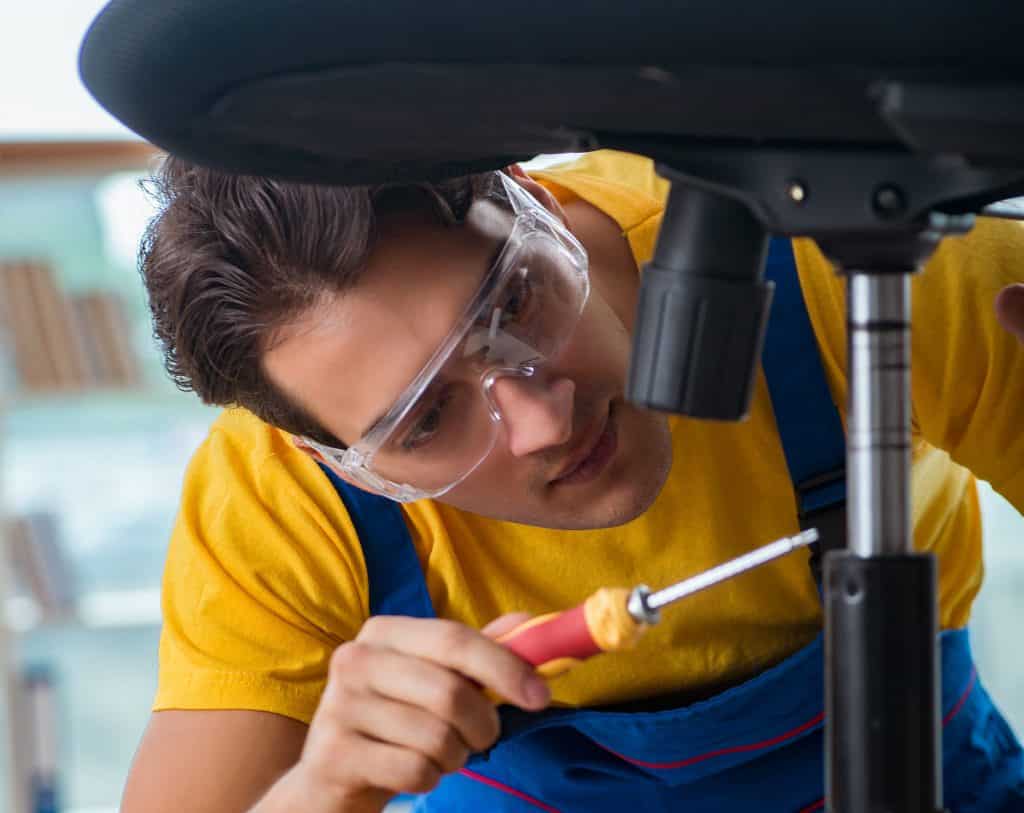*When you buy through links on our site, we may earn an affiliate commission at no additional cost to you.
Standing Desk Vs Kneeling Chair: Which Is A Healthier Option For You?
If you’re torn between getting a standing desk and a kneeling chair for your home office, this guide will help you out.
As you already know, sitting for long periods in your regular chair has been shown to bring up negative effects on your health including obesity, type 2 diabetes, cancer, cardiovascular problems, and even shorten your life![1]
Luckily, both the kneeling chair and standing desk are designed to get you off your office chair and make you kneel or stand—promoting a healthier working environment.
In this guide, we’ll look at the benefits and drawbacks offered by each. This comparison will help you decide which option works best for you.
Table of Contents
Standing Desks Pros and Cons
A standing simply does what its name suggests. It lets you work while standing. The most common standing desk options include a full standalone desk or a standing desk converter that transforms your existing office desk into a standing desk.

Sit-stand desks are mostly height adjustable and allow you to easily go from standing to sitting position. The adjustable height function also accommodates a wide range of users with varying heights.
Standing Desk Pros:
Many office workers love the idea of standing desks due to the many, many benefits they offer them. Below we discuss the key benefits of this type of desk.
Improves your posture
Standing puts you in a natural position, which means a better posture than sitting in an ergonomic chair.
However, you need to set up your standing desk correctly to ensure an improved stance.
Adjust the desk height so that your head, neck, and spine are correctly aligned. Make sure your spine assumes the natural “S” curve which your head is slightly back and hips are straight ahead. Your computer, too, should be at or below your eye level.
If you don’t set your desk correctly, you may lean your body forward, leading to poor posture habits.
Minimizes fatigue
One of the problems office workers is feeling tired and sluggish due to sitting in an office chair for long hours. But using a standing desk saves you from this issue.
It makes you stay active, which helps keep your energy levels much more consistent and enables you to do more throughout your workday.
Aids in weight loss
Standing will burn more calories than sitting, and a standing desk makes this happen. This gives it an edge over sitting down in your office chair, which is associated with increased weight gain and obesity with time.

However, it’s important to keep in mind that you won’t burn calories at a high rate while standing as you’d while walking, cycling, running, etc.
So, don’t ditch your exercise routine when you start using a standing desk, think it will work for burning calories and keeping you in shape.
Increases productivity
Ever wondered why your mind starts to wander and you lose focus after too much sitting in your office chair?
One of the reasons is that you stay in the same position for many hours without moving.
But the opposite happens when you switch to standing desks. It’s unnatural to stand and not move around.
Whether it’s the occasional side-to-side rocking or stepping up and down, this helps promote active working.
The active working environment increases blood flow, high energy levels, and improved concentration and focus.
Height adjustable
Unlike your existing desk, which has is fixed, nearly all the standing desks available today are height adjustable. You can also get an electric standing desk which makes the adjustment process even easier.
This is a great feature because it enables users of varying heights, including short and tall, to customize their desks for the most ergonomic fit.
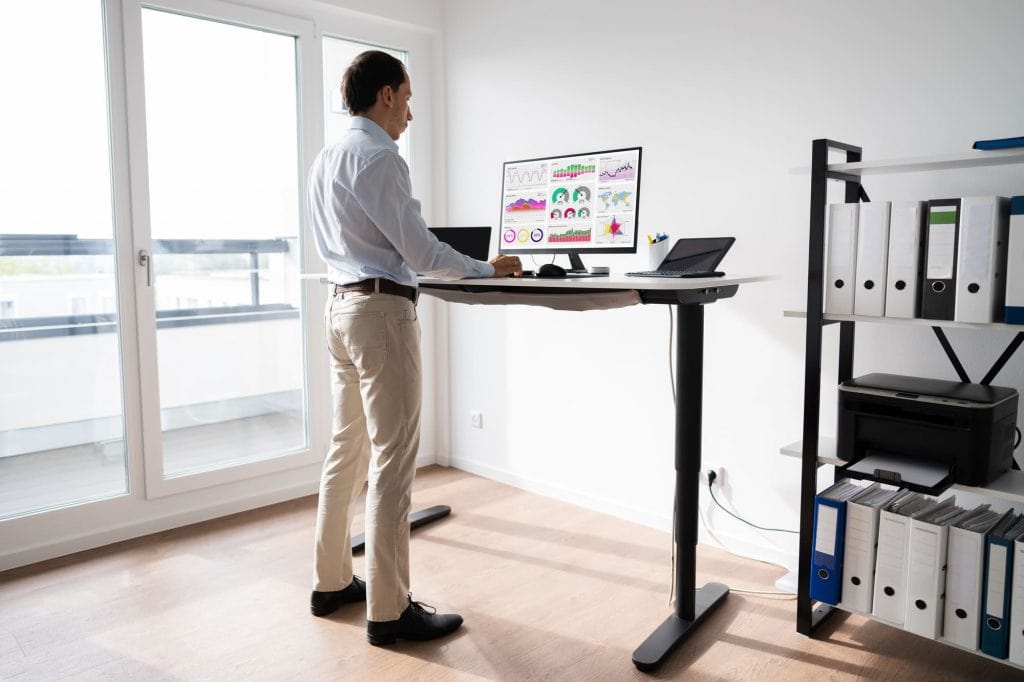
It also makes it easy for users to use these desks with kneeling chairs, under desk bikes, and other exercise machines that keep you active while working.
The height adjustment function also makes it easy for you to take these desks from sitting to standing positions, so you can switch between these work positions.
Standing Desk Cons:
Despite all the exciting benefits of standing desks we’ve discussed above, they’re not without some problems.
You should be aware of the following downsides of the standing desks before you start using one.
Legs and feet pain
Standing in front of your desk for a long time can make your leg and feet sore. This can get even worse if you stand on cemented or uncarpeted floor.
That’s why we recommend using your standing desk for short doses. You may want to wear supportive shoes to help protect your feet.
Alternatively, put an anti-fatigue mat beneath your standing desk to cushion your feet and legs and prevent them from getting sore and feeling pain.
Not ideal for use throughout the day
Having discovered the many health benefits a standing desk offers you, you may be tempted to use it for long hours to maximize these benefits.
But this is a bad idea. Standing for long hours comes with serious side effects.
For instance, standing for full 8 hours of work creates pressure that blocks blood circulation in the veins, increasing the possibility of varicose veins.
So, how long should you use your standing desk?
We recommend using the desk for 1 hour for every 2 hours you sit (i.e., in the ratio 1:2).
If you don’t want to go back to sitting, you can simply take 30-minute walks or do some exercises to break from the static standing position.
Also, when using a standing desk, try shifting your body weight, varying positions, moving around, etc.
This is a sure way to avoid the effects of standing for long periods.
Using standing desk chairs can also help you take breaks from standing.
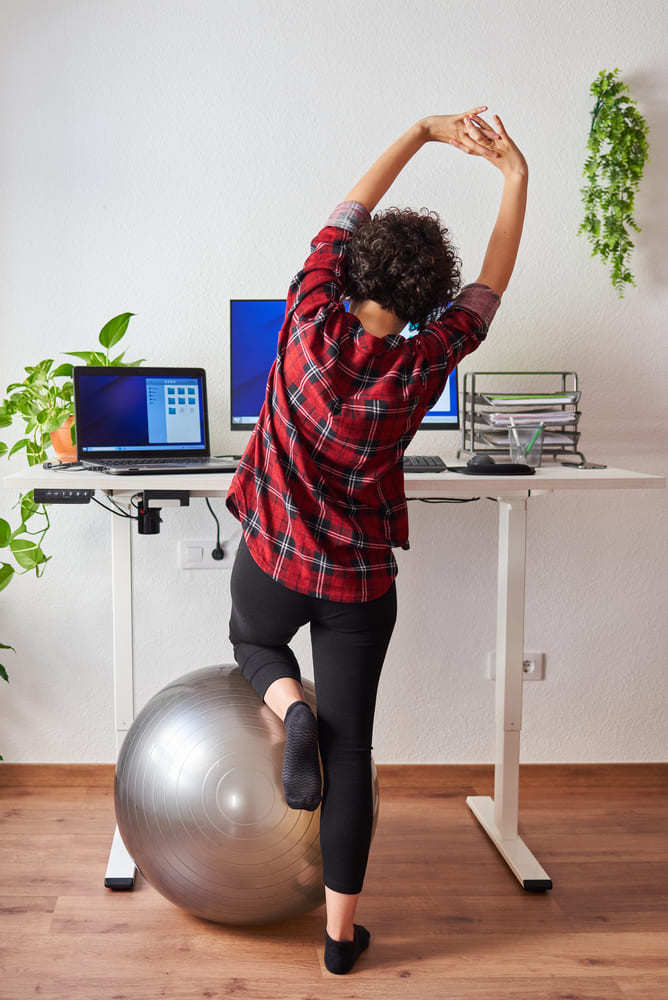
Take, for instance, the drafting standing desk chairs which give you the same level of comfort as the traditional chairs.
Most standing desk users prefer the leaning standing desk chairs (also known as a leaning stool). The best leaning stools promote active sitting while letting you rest your feet as you work on your standing desk.
Kneeling Chairs Pros and Cons
A kneeling chair varies from a standing desk in that it doesn’t necessarily get you off the office chair. It is essentially a chair. But it helps alter your style of sitting to fight health problems like lower back pain associated with a sedentary lifestyle.

While ergonomic chairs sit your thighs at a 90-degree angle, kneeling chairs drop them more to about 60-70 degrees. This helps shift your body forward and let the shin rests take the pressure off your back and bottom.
Kneeling Chair Pros:
The best kneeling chair will offer you multiple benefits. They promote good posture, reduce or prevent back pain, and so much more.
Let’s take a closer look at the key benefits you enjoy when you use a kneeling chair.
Improves your posture
One of the problems with standard chairs is that it is easy to slouch and slump as you spend long hours in them.
Even if you use a highly ergonomic chair, the urge to slump into the spine-damaging pose will always be there.
But this isn’t the case with a kneeling chair. Sitting in this chair pushes your pelvis forward.
The unique way you sit in these chairs leaves you with no choice but to force your spine into its natural curvature.
Consequently, you assume an upright position and proper posture.

Reduces or prevent back pain
A kneeling chair forces you to sit upright. This leads to a natural spine shape and helps reduce pressure on your lower back.
This will not only help reduce pain in your lower back caused by sitting in the traditional chair.
Kneeling chairs also evenly distribute your body weight around parts of the body. This helps reduce pressure around your back area and minimizes or prevents back pain.
Still, kneeling chairs open up your hip area, which may help with hip pain reduction and minimal compression around this area.
Strengthens your core and back muscles
Most kneeling chairs are available without backrests. This means when you sit on them, you will rely on core and back muscles for support.
As you continue activating these muscles every minute you sit on the kneeling chair, they get stronger. And you’ll even notice improved core strength and muscle tone over time.
Strong core muscles can help reduce the risk of injury while giving you the strength and stability needed in other areas of your life.
Improves breathing and digestion
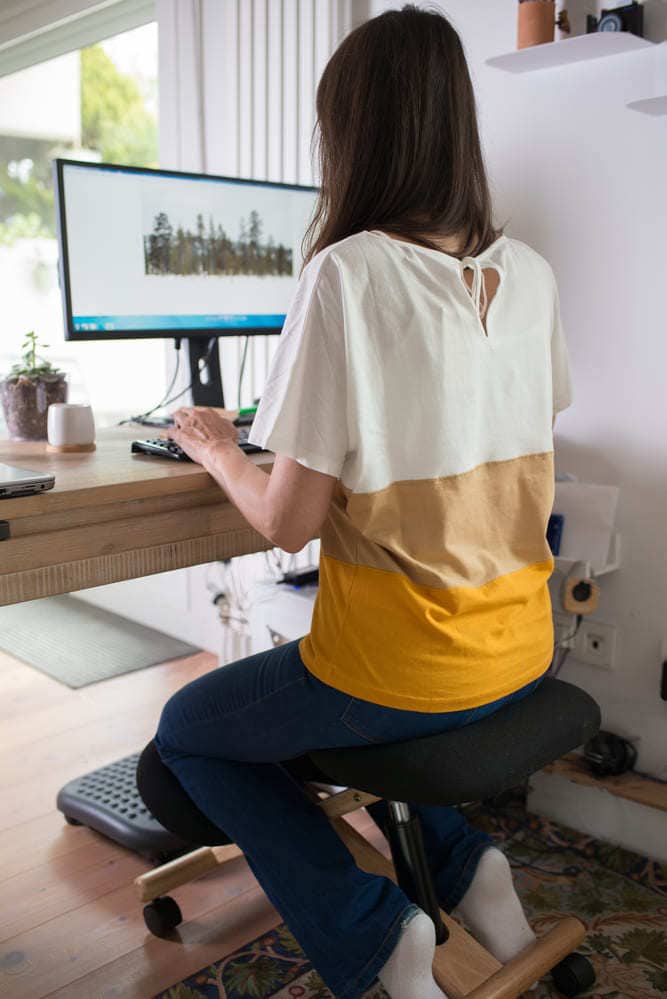
Picture when you’re sited in a standard chair. Your body becomes all scrunched up, and your internal organs responsible for breathing, digestion, and other crucial bodily functions aren’t spared.
These organs are put in a position that restrains them from performing at their best.
On the other hand, kneeling chairs put your lungs and other organs in a way that they’re able to function at their best.
As such, you can breathe easily, digest food readily, and your comfort level increases.
Increases concentration
One of the killers of productivity among office workers is fatigue. Fatigue is a direct byproduct of poor posture.
Fortunately, a kneeling chair will help reduce fatigue by aligning your spine correctly. Good stance means unrestricted blood flow and increased oxygen levels in your brain.
The end result is a significant increase in comfort and concentration.
Adjustable for an ergonomic fit
One area where kneeling chairs vs standing desks even out is that they let you adjust them for a more ergonomic fit.
Most kneeling chairs feature seat height adjustment to allows users of different body heights to comfortably fit into them
They also provide you with seat angle adjustment. This important feature lets you set your chair at an angle that promotes a comfortable sitting experience.
Kneeling Chair Cons:
Just like we have seen in the standing desks, the kneeling chairs also have a few drawbacks you need to know before getting one. These include:
Puts pressure on your shins
One of the downsides of using a kneeling chair is that it can put more pressure on your shins and knees.
Though the body’s weight is evenly distributed across your body, your shins will still take a little weight. They may not be used to it and may feel pain with extended use.
However, you can avoid this by getting a kneeling chair with more comfortable padding for the knee rests.
Restricts your movement
Using a kneeling chair makes it impossible for you to move your legs, tap your feet, swivel your hips and shoulders, etc. This is unlike when using a traditional chair or a standing desk.
Models with separate knee pads are said to offer you some flexibility in movement. But they still put a huge restriction on your ability to move your legs and other body parts.
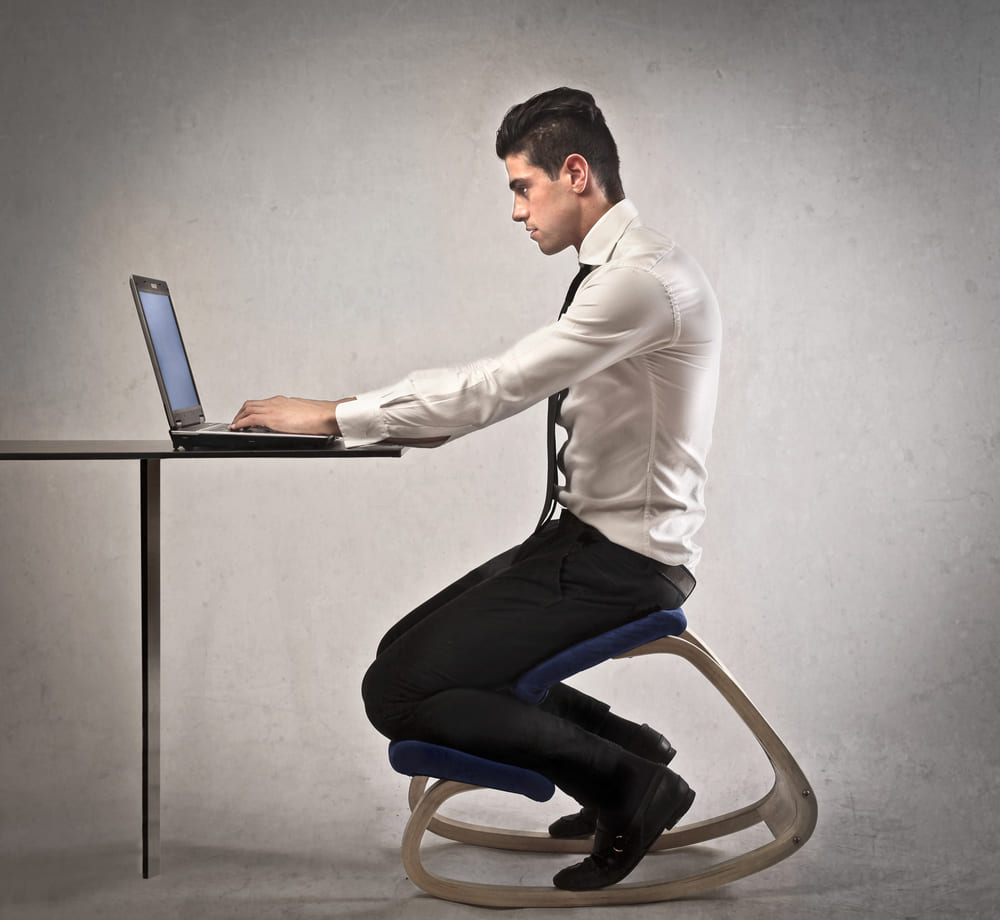
This restricted movement can cause pain to your body, especially if you hang in there for a prolonged period.
Gradually transitioning to a kneeling desk chair will help you counter this.
Sit in it for a few minutes when starting out, and then get off it to stretch and exercise. Increase the time you use it as you get used to it.
Takes time to get in and out of a kneeling chair
It takes time to get into and off a kneeling chair. It’s also not easy to get into and out of this chair as you do on a regular office chair.
You’ll need to practice using this chair, and it may take some time before you get used to it.
Again, the secret is to not use it too much at a time when you’re just getting started.
Not ideal for use for long hours
Kneeling chairs aren’t generally meant for use for long hours. They’re primarily for doing short-term tasks.
People who use them for prolonged periods, up to full 8 hours, will end up feeling discomforts and even body aches.
Even if you’re planning to use a kneeling chair, you should forget about your traditional chair.
You can alternate between them to avoid using either chair for too long.
Not practical for all users
If you have bad knees or mobility issues of any kind, kneeling chairs may not be practical for you. Many users who suffer from mobility issues will find it hard to get in and out of the chair. And those with bad knees will put themselves in a situation that brings up discomforts.
Final Thoughts – Standing Desk Vs Kneeling Chair
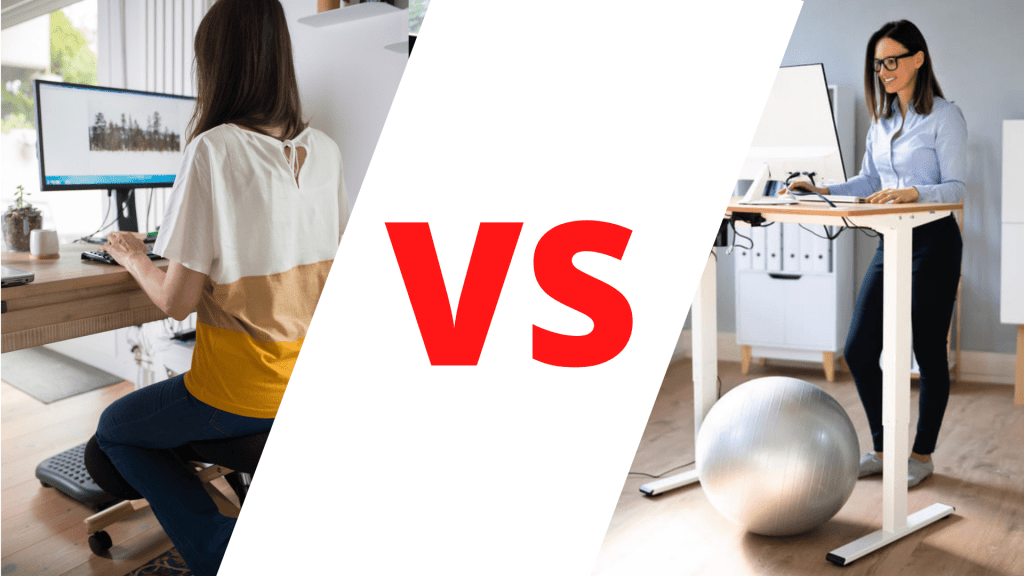
It can be quite confusing trying to decide whether to get a kneeling chair or a standing desk due to the varying opinions from many users all over.
But after reading our in-depth kneeling chair vs standing desk comparison above, you should be in a better position to decide which one will serve your needs.
A standing desk is the best option for keeping you active while working, preventing weight gain, reducing fatigue from too much sitting, and improving productivity.
You should consider a kneeling chair if you want to improve your stance, build core muscles, and reduce/prevent back pains.
Alternatively, you can get both the sit/stand desk and kneeling chair. The two are meant to be used for short doses, making them a perfect pair.
Alternating between the two will enable you to enjoy the best of both worlds.



